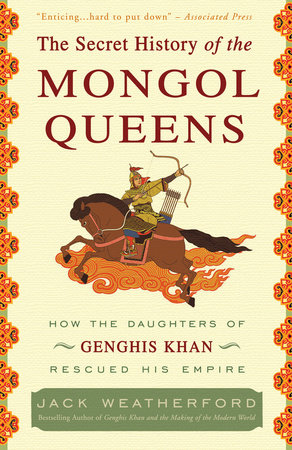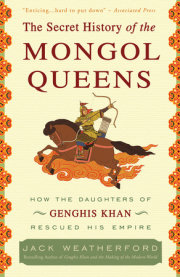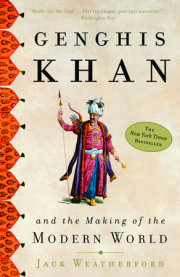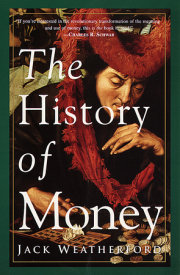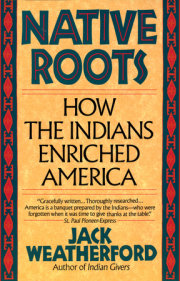1
It Takes a Hero
Arenegade Tatar with the knife of vengeance hidden in his clothes slowly crept toward the camp of Genghis Khan's elderly mother, Hoelun. He sought revenge against Genghis Khan, who clans annihilated the ancient Tatar had, killed many of their warriors, married their women, and adopted their children, even changing their names to make them Mongol.
As a military and political leader with many enemies, Genghis Khan lived in a well-guarded encampment where bodyguards had strict orders to kill anyone who crossed a precise point without permission. Hoelun, however, lived apart in her own camp, and although she now had ten thousand soldiers and their families assigned to her control, at her advanced age she let her youngest son take her part of the army out on missions with her eldest son, the khan, while she stayed home.
Despite her rank, Hoelun's camp differed little from that of any other Mongol nomad. It consisted of a small collection of gers, the round tent of the steppes, positioned in a straight line with the doors facing south. Often called a "yurt" in the West, the Mongol ger was made of thick layers of felt wool pressed into large blankets, and could be packed up and moved as the seasons changed or as whim dictated.
The clearest sign that this was the imperial camp of the khan's mother was the presence of Hoelun's white camel and black cart. Women owned the gers and all the carts, but as befits a nomadic people, a woman was better known by her mode of transportation than by her home. Younger women rode horses; older women drove carts. Unless gravely ill or seriously injured, a man could never ride on a woman's cart, much less drive it.
Mongol carts of this time consisted of a small wooden bed above the axle and two wheels. Extending from the front were the two long shafts, between which the draft animal pulled the cart. All carts had the same black covering and looked much alike, but a woman showed her individuality in the choice and training of the draft animal. Common women drove a lumbering ox or a woolly yak before their heavily laden carts, but in her older years Hoelun had become fond of a high-stepping white camel to cart her around in the impressive manner appropriate for the mother of the emperor. She was known to travel long distances very quickly and even to travel at night. Since camels of any sort, much less white ones, were not very common north of the Gobi, her camp was easy to find and identify.
As the Tatar approached the camp, few men could be seen except her guards, Jelme and Jetei. Befitting her status, Hoelun had men rather than dogs to guard the area around her ger, and since her son Genghis Khan had a great fear of dogs, she kept none around to sound the alarm of an intruder. The Tatar waited until an opportune moment when the guards were distracted. The two men intended to butcher a hornless black ox, which they would do by knocking it unconscious with a single are blow to the middle of the forehead; if that blow did not kill the animal, they plunged the knife into the back of the neck or the throat. Since such a profane act could never be done near an entryway or in the presence of the sun, the guards dragged the beast toward the shadowed north side behind the ger. The ox would be out of sight of the door, but so would they.
As soon as the guards passed out of sight, the would-be assassin headed straight for the door, which consisted of a felt blanket draped over an opening about four feet high. The Tatar raised the flap and entered.
Hoelun had no reason to suspect the cruel intent of the bedraggled young man standing before her, and, although the mother of the most powerful chief on the steppe, she continued to observe the simple traditions of hospitality followed by every nomadic family. Any traveler arriving at her tent could expect hot food and rest before continuing across the steppe. A gentle fire of dried animal dung, the focal point of the ger and the symbol of the family, burned constantly in the center of the open space beneath a smoke hole that also served as the only window in the structure. Milk and water always stood ready, awaiting the arrival of any lost hunters, chilled herders, returning warriors, and other passing strangers in need of food, warmth, or simple human companionship. If no fresh meat was available, dried beef and yak hung in the rafters; by adding these to water, Hoelun could produce a nourishing soup within minutes. She might offer the traveler a bowl of broth or a small snack of sheep tail fat that could be held over the glowing dung to cook. Soup was their staple, and the Mongols rarely added herbs, spices, or flavoring other than trace amounts of salt.
Although her husband had been killed by the Tatars nearly twenty-five years earlier, she would not have been suspicious of this Tatar now. The Tatar tribe had been thoroughly incorporated into the Mongol nation. Genghis Khan had married a Tartar queen and, at her request, had also accepted her elder sister as a wife. In an effort to set a good example for other women of the tribe, Hoelun had adopted a Tatar orphan, raising him to become one of the first people to read and write the Mongolian language, using the recently borrowed Uighur script. He had grown into a respected leader, and, although not a great warrior, he would soon become the supreme judge of the nation.
When the Tatar arrived, Hoelun was alone in the ger with Altani, a girl about ten to fourteen years old. Altani may have been one of Hoelun's granddaughters, or perhaps an adopted child.
Hoelun and Altani remained on the eastern side of the tent, where women did most of their work and kept their tools. By custom, even the humblest visitor could enter unannounced and sit quietly by the door on the western (the male) side of the ger. The Tatar did precisely that, assuming the place assigned for an ordinary man, servant, beggar, or other humble petitioner.
The inside of the ger was normally a quiet haven. People whispered. Gestures had to be kept to a minimum in an environment where a simple toss of the hand or flick of the wrist might hit grandmother in the head, knock over a bowl of hot tea, or even bring down a low ceiling rafter or part of the wall. To make the body as small as possible when seated, Mongols rarely stretched out their legs, and never did so in the direction of the fire. A male usually folded one leg under his body and drew the knee of the other leg up to his chest, wrapping his arm around it or even resting his chin on it. Inside the ger, everyone sought to become as unimposing as was practicable.
Even if Hoelun had known that the visitor carried a knife, she would not have been surprised or alarmed. Herders often concealed knives and other tools inside their garments. Men and women wore the same basic clothing, and it was ideal for hiding things. Large leather boots came up to the knees, but they were spacious enough inside to allow for thick strips of winter insulation of fur and felt. The main clothing was the deel: a large tunic coat held in place by a massive leather belt or cloth sash, while a few knotted buttons secured the top over the right breast. The most noted characteristic of Mongol clothing was its bulky size, as it was made for insulation and for comfort when riding in cold weather. The deel was always large enough to enclose a child, a lamb, or anything else requiring protection. Because of the fierce cold, herders packed an assortment of goods inside the deel, such as water canteens and food, to prevent them from freezing.
The sleeves were so large and long that a sword could be easily hidden in one. Because the herders' hands needed to be free for work, they did not wear gloves; instead they had wide, open sleeves that hung down several inches past the fingertips. While riding horses in the winter, a Mongol pulled the reins up into the sleeve of the coat so as to have warmth without sacrificing the sensitive details of holding the reins firmly against the naked flesh of the fingers.
Hoelun, Altani, and the Tatar would have been dressed nearly identically except for their hair. All the decorative and sexual symbolism of their appearance was concentrated on the head. Women pulled the hair high on their head and packed it with animal fat to prevent lice. To make the forehead appear large, they emphasized it by smearing it with yellow makeup. By contrast, men wore a small clump of bangs in the middle of the forehead directly above the nose. Aside from the bangs, men shaved most of the head except for two large clumps just above each ear. They never cut these tufts, but instead braided them into "horns" that hung down to the shoulders and often grew so long that they had to be looped back over the ear.
The Great Khan's mother knew how to deal with men and certainly did not fear them; she had already raised ten boys, including the four she had with her husband, two that he had with another wife, plus the four she adopted after becoming a widow. Even now she had two children staying with her, and at least one of her sons or grandsons was probably about the same age as the Tatar who was now within an arm's reach of her.
In her old age, Hoelun was raising not only Altani but also Tolui, Genghis Khan's youngest son and her youngest grandson. Tolui had just reached the age when he could run around outside the ger by himself. From the time children could crawl, they needed to be constrained. Infants were held gently and passed constantly from person to person or, when necessary, were tightly tied with a rope to keep them away from the flames of the fire.
Copyright © 2010 by Jack Weatherford. All rights reserved. No part of this excerpt may be reproduced or reprinted without permission in writing from the publisher.

